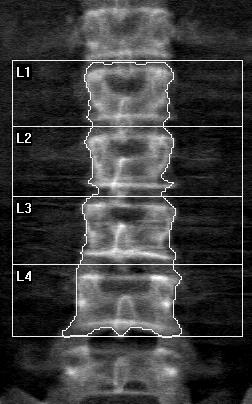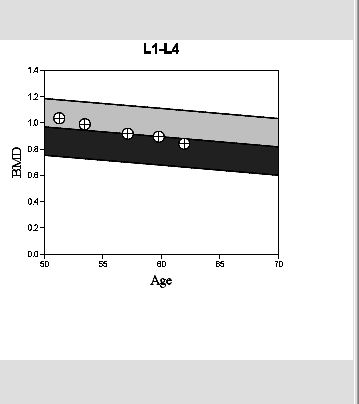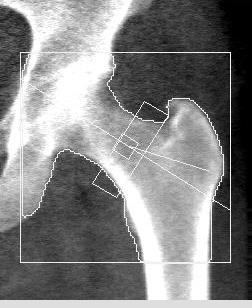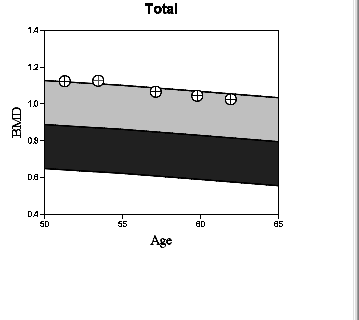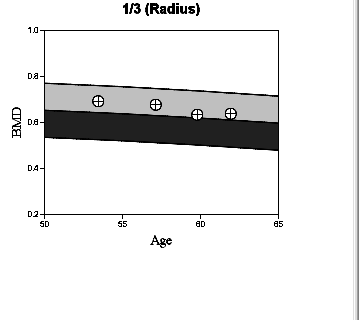Bone Density Study
History and Osteoporosis Risk Factors This patient is a 61 year old postmenopausal woman who has experienced no known fragility fractures since age 45. According to a standardized questionnaire, this patient reports the following risk factors for osteoporosis and/or fractures: post-menopausal status at age 52. Current and Past Treatment This patient reports current intake of the following which may benefit skeletal health: diet high in calcium, multivitamin and vitamin D supplement. Past treatment includes: calcium supplements. Results
* Based on internationally accepted standards, the T-scores are now calculated by comparing the patient's bone density (BMD) to a database of normal, white adults (age 25 to 30) of the same gender. Results are reported as standard deviations from the mean BMD. ** Z-scores compare the patient's BMD to his or her age-matched peers of the same ethnicity if a sufficiently large ethnic database is available, (ie. if ethnicity is white, black, or Hispanic). For other ethnic groups, a white, age-matched database is used for comparison. Diagnosis According to diagnostic criteria established by the World Health Organization, these results indicate Low Bone Mass (osteopenia) in at least one skeletal site.Comparison To Prior Studies Bone density decreased progressively by 18.9% in the total PA spine between 1/13/2009 and 9/7/2019. Bone density in the total left hip was stable between 1/13/2009 and 3/10/2011. Since 3/10/2011 the total left hip bone density has decreased significantly by 9.0%. Bone density decreased significantly by 8.7% in the radius 1/3 between 3/10/2011 and 7/13/2017. Since 7/13/2017 the radius 1/3 bone density has been stable. |
Confidentiality/Disclosure Warning: This transmittal contains privileged and confidential information intended for use by a physician. Use, copying, or distributing by any other person is strictly prohibited. If you have received this transmittal in error, please notify us by telephone at 877-392-7763 and return the misdirected transmittal to us by U.S. mail. (See address at top of document). Page 1 |
Impression and Recommendations Based on gender, current age, hip bone density, BMI and ethnicity, this patient's 10 year risk for major osteoporotic fractures is 6.7%. The 10 year risk for hip fracture is 0.3%. The level of fracture risk does not meet current NOF guidelines for pharmacologic therapy.This calculation of 10-year fracture risk using the WHO FRAX(R) (v3.6) algorithm is based on information provided by the patient per questionnaire. Other clinical information which could affect fracture risk and/or the benefit:risk ratio of therapy should also be considered in making therapeutic decisions.Although this patient's bone density remains above the level which requires pharmacologic intervention, significant bone loss has been documented by serial bone density testing which will lead to loss of bone strength if it continues. For this reason, assessment of adequacy of vitamin D and calcium malabsorption and/or hypercalciuria could be considered. Adequate calcium, vitamin D and regular weight bearing exercise should be encouraged along with follow-up bone density testing to determine if bone loss is continuing. Consider repeat bone density testing in 2 years.For monitoring, follow-up bone density testing must be performed on the same machine. Otherwise, it may be impossible to tell whether changes in bone density are due to machine variations or to a true change in the patient.
|
Confidentiality/Disclosure Warning: This transmittal contains privileged and confidential information intended for use by a physician. Use, copying, or distributing by any other person is strictly prohibited. If you have received this transmittal in error, please notify us by telephone at 877-392-7763 and return the misdirected transmittal to us by U.S. mail. (See address at top of document). Page 2 |
Current Studies
| ||||||||||||||||||||||||||||||||||||||||||||||||||||||||||||||||||||||||||||||||||||||||||||||||||||||||||||||||||||||||
Confidentiality/Disclosure Warning: This transmittal contains privileged and confidential information intended for use by a physician. Use, copying, or distributing by any other person is strictly prohibited. If you have received this transmittal in error, please notify us by telephone at 877-392-7763 and return the misdirected transmittal to us by U.S. mail. (See address at top of document). Page 3 |
Current Studies
| ||||||||||||||||||||||||||||||||||||||||||||||||||||||||||
Confidentiality/Disclosure Warning: This transmittal contains privileged and confidential information intended for use by a physician. Use, copying, or distributing by any other person is strictly prohibited. If you have received this transmittal in error, please notify us by telephone at 877-392-7763 and return the misdirected transmittal to us by U.S. mail. (See address at top of document). Page 4 |


